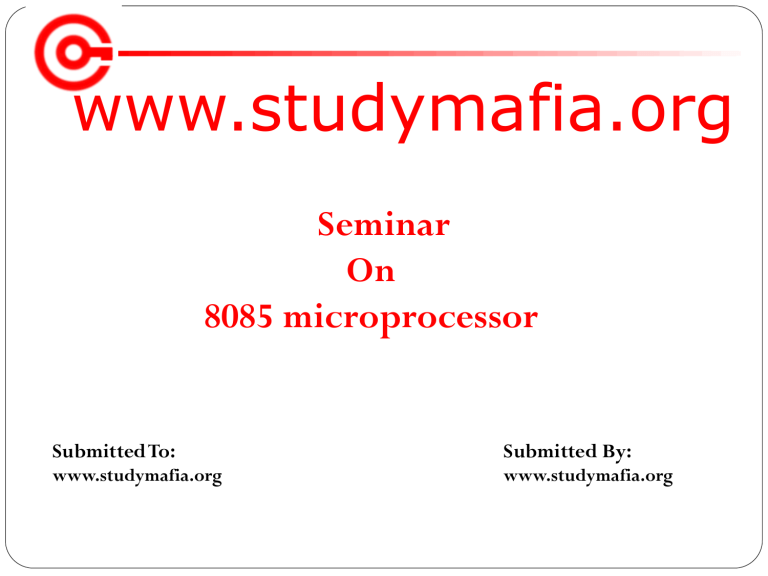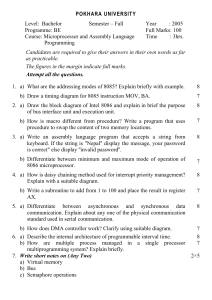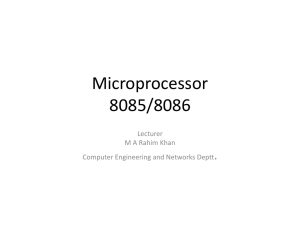
www.studymafia.org Seminar On 8085 microprocessor Submitted To: Submitted By: www.studymafia.org www.studymafia.org Content Introduction Features Pin Configuration Architecture 0f 8085 The 8085 Bus Structure Instruction Set Addressing Modes Timing diagrams Reference Introduction Microprocessor is a Central Processing Unit (CPU) etched on a single chip. A single Integrated Circuit (IC) has all the functional components of a CPU namely Arithmetic Logic Unit (ALU), Control Unit and registers. The 8085 microprocessor is an 8-bit processor that includes on its chip most of the logic circuitry for performing computing tasks and for communicating with peripherals. Features 8 bit microprocessor(8085 microprocessor can read or write or perform arithmetic and logical operations on 8-bit data at time) It has 8 data lines and 16 address lines hence capacity is 216 = 64 kB of memory Cock frequency is 3 MHz It requires +5V power supply. It is a single chip NMOS device implemented with 6200 transistors. It provides 74 instructions with five addressing modes. It provides 5 hardware interrupt and 8 software interrupts. Pin Configuration 40 pins classified into 6 groups: 1. Data bus 2. Address bus 3. Control & status lines 4. Externally generated 5. Serial interface 6. Power supply & clock Pin Configuration cont… 1) Address Bus (A15-A8 and AD7-AD0): The microprocessor 8085 has 16 bit address lines from A15-A8 and AD7-AD0. These lines are used to transfer 16 bit address of memory as well as 8-bit address of I/O ports. 2) Data Bus: The lower 8 lines (AD7-AD0) are often called as multiplexed data lines. CONTROL LINES RD : Read: This is active low signal which indicates that the selected I/O or memory device is to be read and also is available on the data bus. WR : Write: This is active low signal which indicates that the data on data bus are to be written into a selected memory location. IO/ M : (Input / Output / Memory): This is used to select either Input / Output devices or memory operation. When it is high it indicates an I/O operation and when it is low, it indicates a memory operation. STATUS LINES Status Pins (S1, S0): The microprocessor 8085 has two status pins as S1, S0 which is used to indicate the status of microprocessor or operation which is performed by microprocessor. SPECIAL SIGNAL ALE (Address Latch Enable): The ALE signal is used to enable or disable the external latch IC (74373/8212). The external latch IC is used for the de-multiplexing of AD7-AD0 lines, i.e., it is used to separate the address and data from AD7-AD0 lines. If ALE = 1/0 then external latch IC is enabled / disabled respectively. Architecture 0f 8085 1. 2. 3. 4. 5. 6. 7. ALU Timing and Control Unit General Purpose Registers Program Status word Program Counter Stack Pointer Instruction Register and Decoder 8. Interrupt Control 9.Serial I/O Control 10.Address Bus 11. Data Bus PROGRAMMING MODEL OF 8085 REGISTERS The Registers are of 8-bit & 16-bit size used for different purposes A- Accumulator – This is an special purpose register. All the ALU operations are performed with reference to the contents of Accumulator. B,C,D,E,H,L – General purpose registers. These registers can also used for 16-bit operations in pairs. The default pairs are BC, DE & HL. F – Flag register – This register indicates the status of the ALU operation. PC – Program Counter – This is a 16-bit register used to address the memory location from where an instruction is going to be executed. SP – Stack pointer - This is a 16-bit register used to address the top of the stack memory location. Temporary register, W & Z – These registers are only used by 8085 and are not available for the programmer. ALU – Arithmetic & Logic Unit ALU of 8085 performs 8-bit arithmetic & logical operations. The operations are generally performed with Accumulator as one of the operands. The result is saved in accumulator register. Timing & Control Unit This unit works as the brain of the CPU and generates all the timing and control signals to perform all the internal & external operations of the CPU. Instruction Decoder & Machine Cycle Encoder Unit This unit decodes the op-code stored in the Instruction Register (IR) and encodes it for the timing & control unit to perform the execution of the instruction. The 8085 Bus Structure The 8-bit 8085 CPU (or MPU – Micro Processing Unit) communicates with the other units using a 16-bit address bus, an 8-bit data bus and a control bus. Over all structure A15- A10 Chip Selection Circuit 8085 CS A15-A8 ALE AD7-AD0 WR RD IO/M Latch A9- A0 A7- A0 1K Byte Memory Chip D7- D0 RD WR MPU Communication and Bus Timing Figure 3: Moving data form memory to MPU using instruction MOV C, A (code machine 4FH = 0100 1111) 21 Instruction Set Broadly classified into two types: Based on word size: One word- Opcode only (CMA, ADD B) Two word- Opcode ,an operand (MVI A,32H) Three word- Opcode, operand, operand (LDA 4200, STA 4500) Based on function: Data transfer group (MOV A,B; MVI A,32H;MOV C,4500) Arithmetic operations (ADD B, SBI 32H,INC D, DEC B) Logical operations (ANA B, ORI 05H, RLC, RAR) Branching operations (JUMP, JMP, JNZ, JC, CALL, RETURN) Machine control instructions (HLT, NOP,EI,DI,SIM,RIM) Addressing Modes Immediate (MOV A,B ;ADD B; SUB E;ANA C) Register (MVI A,05H;LXI B, 20AEH; ADI 05H;ORI 07H) Direct (LDA 4500H;STA 7500H;IN 09H;OUT 70H) Indirect (MOV A, M;MOV M,A;ADD M;ORA M) Implied(implicit) (HLT; NOP;RST;RET) Timing diagrams The 8085 microprocessor has 7 basic machine cycle. They are 1. Op-code Fetch cycle(4T or 6T). 2. Memory read cycle (3T) 3. Memory write cycle(3T) 4. I/O read cycle(3T) 5. I/O write cycle(3T) 6. Interrupt Acknowledge cycle(6T or 12T) 7. Bus idle cycle References www.google.com www.wikipedia.com www.studymafia.org www.pptplanet.com Thanks



